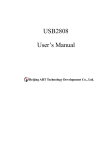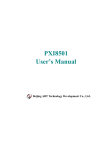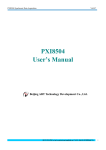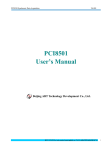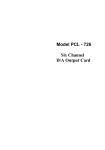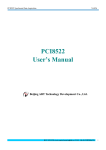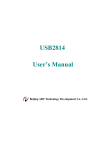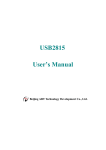Download PCI8002A User`s Manual
Transcript
PCI8002A User’s Manual Beijing ART Technology Development Co., Ltd. Contents Contents.............................................................................................................................................................................. 2 Chapter 1 Overview ........................................................................................................................................................... 3 Chapter 2 Components Layout Diagram and a Brief Description..................................................................................... 5 2.1 The Main Component Layout Diagram................................................................................................................ 5 2.2 The Function Description for the Main Component............................................................................................. 5 2.2.1 Signal Input and Output Connectors ......................................................................................................... 5 2.2.2 Potentiometer ............................................................................................................................................ 5 2.2.3 Jumper ....................................................................................................................................................... 6 2.2.4 Physical ID of DIP Switch......................................................................................................................... 7 2.2.5 Status Indicator.......................................................................................................................................... 8 Chapter 3 Signal Connectors ............................................................................................................................................. 9 3.1 Analog Input Connector (AI0~AI3) ..................................................................................................................... 9 3.2 Signal Input/Output Connector ............................................................................................................................ 9 3.3 Digital Input/Output Connector.......................................................................................................................... 10 3.4 Analog Input....................................................................................................................................................... 10 3.5 Trigger signal input ............................................................................................................................................ 11 3.6 Digital Input ....................................................................................................................................................... 11 3.7 Digital Output..................................................................................................................................................... 11 3.8 Sync pulse signal input....................................................................................................................................... 12 3.9 Sync pulse signal output..................................................................................................................................... 12 3.10 Methods of Realizing the Multi-card Synchronization .................................................................................... 12 Chapter 4 The Instruction Trigger Function .................................................................................................................... 14 4.1 Internal Trigger Mode ........................................................................................................................................ 14 4.2 External Trigger Mode ....................................................................................................................................... 14 4.3 Analog Trigger Function .................................................................................................................................... 14 Chapter 5 Methods of Using Internal and External Clock Function ............................................................................... 16 5.1 Internal Clock Function...................................................................................................................................... 16 5.2 External Clock Function..................................................................................................................................... 16 5.3 A/D Data Bit High Bit Control........................................................................................................................... 16 Chapter 6 Note and Warranty Policy ............................................................................................................................... 18 6.1 Notes .................................................................................................................................................................. 18 6.2 Warranty Policy .................................................................................................................................................. 18 Products Rapid Installation and Self-check...................................................................................................................... 19 Rapid Installation ..................................................................................................................................................... 19 Self-check................................................................................................................................................................. 19 Delete Wrong Installation......................................................................................................................................... 19 Chapter 1 Overview In the fields of Real-time Signal Processing, Digital Image Processing and others, high-speed and high-precision data acquisition modules are demanded. ART PCI8002A data acquisition module, which brings in advantages of similar products that produced in china and other countries, is convenient for use, high cost and stable performance. ART PCI8002A is a data acquisition module based on PCI bus. It can be directly inserted into IBM-PC/AT or a computer which is compatible with PCI8002A to constitute the laboratory, product quality testing center and systems for different areas of data acquisition, waveform analysis and processing. It may also constitute the monitoring system for industrial production process. Unpacking Checklist Check the shipping carton for any damage. If the shipping carton and contents are damaged, notify the local dealer or sales for a replacement. Retain the shipping carton and packing material for inspection by the dealer. Check for the following items in the package. If there are any missing items, contact your local dealer or sales. ¾ PCI8002A Data Acquisition Board ¾ ART Disk a) user’s manual (pdf) b) drive c) catalog ¾ Warranty Card FEATURES Analog Input ¾ ¾ ¾ ¾ ¾ ¾ ¾ ¾ ¾ ¾ ¾ ¾ ¾ ¾ ¾ ¾ ¾ Input Range: ±5V, ±2.5, ±1V, ±0.5V 16-bit resolution Sampling Rate(sync sample): Max 40MHz; Min 400KHz Input Channels: 4 Analog Input Mode: Single-ended Analog Input Impedance: >10MΩ Chips Number: 4 Data Read Mode: software read mode, DMA mode Memory: 512K word RAM per channel Clock Source: Internal clock and external clock Trigger Mode: software trigger, hardware trigger(external trigger) Trigger Type: edge trigger Trigger Direction: negative, positive, either positive or negative trigger Trigger Level: ±10V Trigger Sensitivity: 1~65535(819) Analog Trigger Source: AI0, AI1, AI2, AI3, ATR System Measurement Accuracy: 0.1% ¾ ¾ Operating Temperature Range: 0℃~55℃ Storage Temperature Range: -20℃~70℃ Digital Input ¾ Input channels: 8 ¾ ¾ ¾ ¾ Electronic standard: TTL-CMOS Maximum absorption current: <0.5mA High level: ≥2V Low level: ≤0.8V Digital Output ¾ Output channels: 8 ¾ ¾ ¾ ¾ ¾ Electronic standard: TTL-CMOS Pull-down current: ≤20mA Pull-up current: ≤2.6mA High level: ≥3.4V Low level: ≤0.5V Other features Board Clock Oscillation: 80MHz Dimension 170.5mm(L) * 111mm(W)*20mm(H) Chapter 2 Components Layout Diagram and a Brief Description 2.1 The Main Component Layout Diagram 2.2 The Function Description for the Main Component 2.2.1 Signal Input and Output Connectors AI0, AI1, AI2, and AI3: Analog signal input ports J1: Analog signal input and output port IN: Sync pulse signal input ports OUT1, OUT2, and OUT3: Sync pulse signal output port 2.2.2 Potentiometer VR_DAF1: Analog output full-scale adjustment potentiometer VR_DAZ1: Analog output zero-point adjustment potentiometer VR_1.25: -2.5V reference power supply adjustment potentiometer 2.2.3 Jumper Select AI0 range: Input Range JP13 JP12 JP15 JP14 ±5V ±2.5V ±1V ±0.5V Select AI1 range Input Range ±5V ±2.5V ±1V ±0.5V Select AI2 range Input Range JP17 JP16 JP19 JP18 ±5V ±2.5V ±1V ±0.5V Select AI3 range Input Range ±5V ±2.5V 2.2.4 Physical ID of DIP Switch DID1: Set physical ID number. When the PC is installed more than one PCI8002A , you can use the DIP switch to set a physical ID number for each board, which makes it very convenient for users to distinguish and visit each board in the progress of the hardware configuration and software programming. The following four-bit numbers are expressed by the binary system: When DIP switch points to "ON", that means "1", and when it points to the other side, that means "0." As they are shown in the following diagrams: "ID3" is the high bit."ID0" is the low bit, and the black part in the diagram represents the location of the switch. (Test softwares of the company often use the logic ID management equipments and at this moment the physical ID DIP switch is invalid. If you want to use more than one device that are the same type in the same system at the same time, please use the physical ID as much as possible. As for the differences between logic ID and physical ID, please refer to the function explanations of "CreateDevice" and "CreateDeviceEx" of The Prototype Explanation of Device Object Management Function in PCI8002AS software specification). ON ID3 ID2 ID1 ID0 ON DID1 1 2 3 4 The above chart shows"1111", so it means that the physical ID is 15. ON ID3 ID2 ID1 ID0 ON DID1 1 2 3 4 The above chart shows"0111", so it means that the physical ID is 7. ON ID3 ID2 ID1 ID0 ON DID1 1 2 3 4 The above chart shows"0101", so it means that the physical ID is 5. ID3 OFF(0) ID2 OFF(0) ID1 OFF(0) OFF(0) 0 0 OFF(0) OFF(0) OFF(0) ON(1) 1 1 OFF(0) OFF(0) ON(1) OFF(0) 2 2 OFF(0) OFF(0) ON(1) 3 3 OFF(0) OFF(0) 4 4 OFF(0) ON(1) ON(1) ON(1) OFF(0) 5 ON(1) ON(1) OFF(0) 5 OFF(0) OFF(0) ON(1) 6 6 OFF(0) ON(1) ON(1) 7 7 ON(1) OFF(0) OFF(0) ON(1) OFF(0) 8 8 ON(1) OFF(0) OFF(0) 9 9 ON(1) OFF(0) ON(1) A 10 ON(1) OFF(0) ON(1) B 11 ON(1) ON(1) OFF(0) C 12 ON(1) ON(1) OFF(0) D 13 ON(1) ON(1) ON(1) ON(1) OFF(0) E 14 ON(1) ON(1) ON(1) ON(1) F 15 2.2.5 Status Indicator L-ER: Hardware error indicator. L-TR: Trigger signal indicator. L-SW: RAM switch indicator. AD_Busy Led: A/D conversion indicator. L-PW: Power supply indicator, on for normal. ID0 ON(1) OFF(0) ON(1) OFF(0) Physical ID(Hex) Physical ID(Dec) Chapter 3 Signal Connectors 3.1 Analog Input Connector (AI0~AI3) BNC Port Red + Black - J1 3.2 Signal Input/Output Connector Pin definition Name Color Description ATR Red AGND White Analog ground. CLKIN/DTR Green External clock input.(do not provide for the moment); digital trigger CAL Yellow 1KHz calibrating signal output SYNOUT Blue Internal clock output. DGND Black Digital ground. Analog trigger signal input. 3.3 Digital Input/Output Connector Pin Name Direction Description DI0~DI7 Input Digital input. DO0~DO7 Output Digital output +5V PWR +5V power supply DGND GND Digital ground. 3.4 Analog Input AI0 AI1 AI2 AI3 AGND 3.5 Trigger signal input ATR DTR DGND AGND 3.6 Digital Input DI0 DI1 DI2 DI7 DGND 3.7 Digital Output DO0 DO1 DO2 DO7 DGND 3.8 Sync pulse signal input IN DGND 3.9 Sync pulse signal output OUT1 OUT2 OUT3 DGND 3.10 Methods of Realizing the Multi-card Synchronization Three methods can realize the synchronization for the PCI8002A, the first method is using the cascade master-slave card, the second one is using the common external trigger, and the last one is using the common external clock. When using master-slave cascade card programs, the master card generally uses the internal clock source model, while the slave card uses the external clock source mode. After the master card and the slave card are initialized according to the corresponding clock source mode. At first, start all the slave cards, as the main card has not been activated and there is no output clock signal, so the slave card enters the wait state until the main card was activated. At this moment, the multi-card synchronization has been realized. When you need to sample more than channels of a card, you could consider using the multi-card cascaded model to expand the number of channels. OUT IN IN Master Card Slave Card 1 Slave Card 2 When using the common external trigger, please make sure all parameters of different PCI8002A are the same. At first, configure hardware parameters, and use analog or digital signal triggering (ATR or DTR), then connect the signal that will be sampled by PCI8002A, input triggering signal from ART pin or DTR pin, then click “Start” button, at this time, PCI8002A does not sample any signal but waits for external trigger signal. When each module is waiting for external trigger signal, use the common external trigger signal to startup modules, at last, we can realize synchronization data acquisition in this way. See the following figure: When using the common external clock trigger, please make sure all parameters of different PCI8002A are the same. At first, configure hardware parameters, and use external clock, then connect the sampled signal, click “Start” button, at this time, PCI8002A does not sample any signal, but wait for external clock signal. When all modules are waiting for external clock signal, use the common external clock signal to startup modules, at last, we realize synchronization data acquisition in this way. See the following figure: PCI8002A Data Acquisition Chapter 4 The Instruction Trigger Function 4.1 Internal Trigger Mode When A/D is in the initialization, if the hardware parameter ADPara.TriggerMode = PCI8002A_TRIGMODE_SOFT, we can achieve the internal trigger acquisition. In this function, when calling the StartDeviceProAD function, it will generate A/D start pulse, A/D immediately access to the conversion process and not wait for the conditions of any other external hardware. It also can be interpreted as the software trigger. As for the specific process, please see the figure below, the cycle of the A/D work pulse is decided by the sampling frequency. Start Enable Convert Pulse The first working pulse after the A/D start pulse Figure 5.1 Internal Trigger Mode 4.2 External Trigger Mode When A/D is in the initialization, if the hardware parameter ADPara.TriggerMode = PCI8002A_TRIGMODE_DELAY or ADPara.TriggerMode-PCI8002A_TRIGMODE_MIDL, we can achieve the external trigger acquisition. In this function, when calling the StartDeviceProAD function, A/D will not immediately access to the conversion process but wait for the external trigger source signals accord with the condition, then start converting the data. It also can be interpreted as the hardware trigger. Trigger source includes the DTR (Digital Trigger Source) and ATR (Analog Trigger Source) The trigger modes include the edge trigger and level trigger. 4.3 Analog Trigger Function When ADPara.TriggerDir = PCI8002A_TRIGDIR_NEGATIVE, it is falling edge trigger. The A/D will begin to work whenever a falling edge occurs on analog trigger signal. The A/D stops when finish a specified length of data sampled and wait for the next trigger signal. When ADPara.TriggerDir = PCI8002A_TRIGDIR_POSITIVE, it is rising edge trigger. The A/D will begin to work whenever a rising edge occurs on analog trigger signal. The A/D stops when finish a specified length of data sampled BUY ONLINE at art-control.com/englishs or CALL 64862359/64861583(CN) 14 PCI8002A Data Acquisition and wait for the next trigger signal. When ADPara.TriggerDir = PCI8002A_TRIGDIR_NEGAT_POSIT, it is either rising or falling edge trigger mode. The A/D will begin to work whenever a rising edge or falling edge occurs on analog trigger signal. The A/D stops when finish a specified length of data sampled and wait for the next trigger signal. BUY ONLINE at art-control.com/englishs or CALL 64862359/64861583(CN) 15 PCI8002A Data Acquisition Chapter 5 Methods of Using Internal and External Clock Function 5.1 Internal Clock Function Internal Clock Function refers to the use of on-board clock oscillator and the clock signals which are produced by the user-specified frequency to trigger the A/D conversion regularly. To use the clock function, the hardware parameters ADPara.ClockSource = PCI8002A _CLOCKSRC_IN should be installed in the software. The frequency of the clock in the software depends on the hardware parameters ADPara.Frequency. For example, if Frequency = 100000, that means A/D work frequency is 100000Hz (that is, 100 KHz, 10uS/point). 5.2 External Clock Function External Clock Function refers to the use of the outside clock signals to trigger the A/D conversion regularly. The clock signals are provide by the INCLK pin of J1. The external clock can be provided by another PCI8002A’s clock output as well as other device such as clock frequency generators. To use the external clock function, set the hardware parameters ADPara.ClockSource = PCI8002A_CLOCKSRC_OUT. The A/D sample rate depends on the external clock frequency. 5.3 A/D Data Bit High Bit Control Analog input’s data bit is D0~D11, D12 bit is over range flag, D15 bit is trigger flag, D13 and D14 are used to show the digital input/output status. Analog Input Data Bit AI0_D13 AI0 AI0_D14 AI1_D13 AI1 AI1_D14 AI2_D13 AI2 AI2_D14 AI3_D13 AI3 AI3_D14 Data bit status Function 0 DI0 edge latch(rising edge valid) 1 DI0 level follow 0 DI1edge latch(rising edge valid) 1 DI1 level follow 0 DI2 edge latch(rising edge valid) 1 DI2 level follow 0 DI3 edge latch(rising edge valid) 1 DI3 level follow 0 DI4 edge latch(rising edge valid) 1 DI4 level follow 0 DI5 edge latch(rising edge valid) 1 DI5 level follow 0 DI6 edge latch (rising edge valid) 1 DI6 level follow 0 DI7 edge latch (rising edge valid) 1 DI7 level follow BUY ONLINE at art-control.com/englishs or CALL 64862359/64861583(CN) 16 PCI8002A Data Acquisition Take AI0 for example to show the edge latch and level follow functions: DI0 AI0_D13 Edge latch DI0 AI0_D13 Level follow BUY ONLINE at art-control.com/englishs or CALL 64862359/64861583(CN) 17 PCI8002A Data Acquisition Chapter 6 Note and Warranty Policy 6.1 Notes In our products’ packing, user can find a user manual, a PCI8002A module and a quality guarantee card. Users must keep quality guarantee card carefully, if the products have some problems and need repairing, please send products together with quality guarantee card to ART, we will provide good after-sale service and solve the problem as quickly as we can. When using PCI8002A, in order to prevent the IC (chip) from electrostatic harm, please do not touch IC (chip) in the front panel of PCI8002A module. 6.2 Warranty Policy Thank you for choosing ART. To understand your rights and enjoy all the after-sales services we offer, please read the following carefully. 1. Before using ART’s products please read the user manual and follow the instructions exactly. When sending in damaged products for repair, please attach an RMA application form which can be downloaded from: www.art-control.com. 2. All ART products come with a limited two-year warranty: ¾ The warranty period starts on the day the product is shipped from ART’s factory ¾ For products containing storage devices (hard drives, flash cards, etc.), please back up your data before sending them for repair. ART is not responsible for any loss of data. ¾ Please ensure the use of properly licensed software with our systems. ART does not condone the use of pirated software and will not service systems using such software. ART will not be held legally responsible for products shipped with unlicensed software installed by the user. 3. Our repair service is not covered by ART's guarantee in the following situations: ¾ Damage caused by not following instructions in the User's Manual. ¾ Damage caused by carelessness on the user's part during product transportation. ¾ Damage caused by unsuitable storage environments (i.e. high temperatures, high humidity, or volatile chemicals). ¾ Damage from improper repair by unauthorized ART technicians. ¾ Products with altered and/or damaged serial numbers are not entitled to our service. 4. Customers are responsible for shipping costs to transport damaged products to our company or sales office. 5. To ensure the speed and quality of product repair, please download an RMA application form from our company website. BUY ONLINE at art-control.com/englishs or CALL 64862359/64861583(CN) 18 PCI8002A Data Acquisition Products Rapid Installation and Self-check Rapid Installation Product-driven procedure is the operating system adaptive installation mode. After inserting the disc, you can select the appropriate board type on the pop-up interface, click the button【driver installation】; or select CD-ROM drive in Resource Explorer, locate the product catalog and enter into the APP folder, and implement Setup.exe file. After the installation, pop-up CD-ROM, shut off your computer, insert the PCI card. If it is a USB product, it can be directly inserted into the device. When the system prompts that it finds a new hardware, you do not specify a drive path, the operating system can automatically look up it from the system directory, and then you can complete the installation. Self-check At this moment, there should be installation information of the installed device in the Device Manager (when the device does not work, you can check this item.). Open "Start -> Programs -> ART Demonstration Monitoring and Control System -> Corresponding Board -> Advanced Testing Presentation System", the program is a standard testing procedure. Based on the specification of Pin definition, connect the signal acquisition data and test whether AD is normal or not. Connect the input pins to the corresponding output pins and use the testing procedure to test whether the switch is normal or not. Delete Wrong Installation When you select the wrong drive, or viruses lead to driver error, you can carry out the following operations: In Resource Explorer, open CD-ROM drive, run Others-> SUPPORT-> PCI.bat procedures, and delete the hardware information that relevant to our boards, and then carry out the process of section I all over again, we can complete the new installation. BUY ONLINE at art-control.com/englishs or CALL 64862359/64861583(CN) 19





















